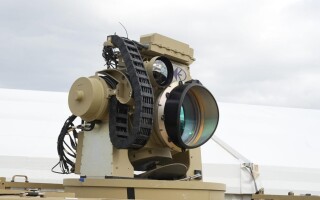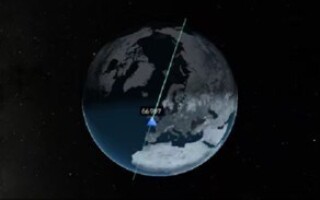Unmanned aircraft systems enable tactical ISR
StoryApril 27, 2015
The U.S. Department of Defense's fleet of unmanned aircraft systems enables tactical intelligence, surveillance, and reconnaissance (ISR) - without endangering military personnel and at a lower cost than manned aircraft.
Unmanned aircraft systems (UASs) range from truly portable hand-launched systems to aircraft the size of helicopters or commercial airplanes. UASs are also much less expensive for the U.S. Department of Defense (DoD) to procure and operate than their manned counterparts.
As defined by the U.S. Federal Aviation Administration, a UAS is: “The aircraft itself and all of the associated support equipment, the control station, data links, telemetry, communications, and navigation equipment, etc., necessary to operate the unmanned aircraft.”
The flying portion of the system, the unmanned aircraft (UA), is flown by a pilot via ground control system or autonomously by using an onboard computer, communication links, or any other equipment deemed essential for the UA to operate safely. Most military UASs carry some sort of payload that gathers information and transmits it – usually in real-time – to a user on the ground to provide enhanced situational awareness.
Small UAS development
When developing small UASs, designers must operate within narrow size, weight, and power (SWAP) constraints. Adding grams of weight to improve any given feature can reduce flight time, so “tradeoffs must be evaluated carefully with respect to customer requirements,” says Chuck Strawbridge, program manager of Unmanned Aircraft Systems for AeroVironment Inc. (Monrovia, California; www.avinc.com).
In terms of footprint, AeroVironment’s Raven unmanned aircraft has a wingspan of 4.5 feet, weighs 4.5 pounds, and can fly for 60 to 90 minutes. It’s the most prolific small UAS within the U.S. fleet – supporting the Army, Marine Corps, Air Force, and Special Operations Command.
Among the hand-launched Raven’s key benefits is that it’s designed to “enable military units to conduct intelligence, surveillance, and reconnaissance over danger zones without committing soldiers,” points out Strawbridge. “Task forces can use it to monitor an area with live video capabilities during day and night operations.”
Operators can control the small UAS with handheld control stations that feature a color monitor to display imagery and data transmitted wirelessly from the air vehicle. Another option is to run it on autopilot; an operator simply determines what they would like to view and the autopilot manages the flight. “A standard ground station controls all AeroVironment’s small UASs to ensure interoperability and operating efficiency,” says Strawbridge.
Range capabilities vary by UAS. In AeroVironment’s line of small UASs, for example, the Puma AE boasts a range of 15 km, while the Raven’s is 10 km, with the Wasp AE and Shrike VTOL each having a range of 5 km. (See Figure 1.)
Figure 1: The hand-thrown Puma AE has a range of 15 km. Photo courtesy of Aerovironment.
(Click graphic to zoom by 1.9x)
“We design all aspects of our UAS to operate effectively and reliably in real-world environments, with Puma AE and Wasp AE ‘all environment’ vehicles capable of landing in salt or fresh water, or on the ground. All operate in light rain and wind conditions, hot weather, and at high altitudes,” Strawbridge adds.
AeroVironment’s small UASs typically rely on electro-optical and infrared sensors, digital links for encrypted communications, autopilots, magnetometers, gyroscopes, altimeters, and other technologies critical for reliability, performance, and reliability.
“COTS (commercial off-the-shelf) devices are used whenever available, and embedded processors and highly integrated programmable devices are used because of SWaP (size, weight, and power) limitations,” notes Strawbridge.
All of AeroVironment’s small UASs use electric-propulsion technology – making them quiet, clean, and powered by easily transportable and rechargeable electric batteries.
In terms of capabilities, small UASs are designed to help soldiers gain situational awareness easily. A squad advancing on a ridgeline, for example, needs to know what lies on the other side. Because squads typically don’t possess or control their own larger aviation assets, small UASs represent a way to quickly gain the situational insight that can mean the difference between safe passage and a dangerous firefight.
“Carried in a soldier’s backpack, a Raven, Wasp AE, or Shrike VTOL system can be assembled, launched, and operated in fewer than five minutes, and provide the squad with an immediate aerial view of their surroundings,” Strawbridge says. “Another example is using a small UAS to monitor the perimeter of a base or to investigate potential threats in a more rapid and accurate manner than through other means.”
This enables the military – as well as law enforcement, environmental, commercial operators, and others – to “improve the effectiveness, efficiency, and safety of their operations,” he adds.
It also helps to significantly reduce costs. More than 85 percent of the DoD’s fleet of unmanned aircraft is comprised of AeroVironment’s UAS – yet it represents less than 5 percent of the DoD’s total spending on UASs.
Larger UASs can carry payload
Larger UASs such as Northrop Grumman Aerospace Systems’ (Falls Church, Virginia; www.ngc.com) MQ-8 Fire Scout, which is roughly the size of a Bell 407 helicopter and weighs 3,150 pounds, are providing greater endurance and a lower cost of operation than their manned counterparts. The MQ-8 is specifically designed to operate safely from any Navy ship with a helicopter deck at sea. The autonomous aircraft is simply controlled with a mouse and keyboard from a ground station onboard the ship. Its advanced control stations use the U.S. Navy’s Tactical Control System, Tactical Common Data Link, and communications, while a modular mission payload capability enables continued growth into new payloads.
By using a payload that includes electro-optical/infrared sensors with a laser rangefinder/illuminator and a maritime radar, the Fire Scout can locate and identify tactical targets, track and illuminate them, and accurately provide targeting data to strike platforms, as well as perform any necessary after-battle damage assessment.
Northrop Grumman “leverages software on our larger unmanned air vehicles, particularly when it comes to the vehicle management system,” says Tom Twomey, business development manager for Northrop Grumman’s Fire Scout program. MQ-8 has “a 12-hour endurance and can operate 150 nautical miles from the ground station,” Twomey adds. “It’s also designed to operate in the same harsh environments as manned helicopters.”
The key benefits of larger UASs are similar to those of smaller UASs: the ability to operate within dangerous areas or hostile territories for maritime and overland ISR missions – without risking a manned aircraft.
“The U.S. Navy is now also combining unmanned aircraft with manned aircraft as a force multiplier – enabling coverage of more area at longer endurances, and at a lower cost to the DoD,” notes Twomey.






